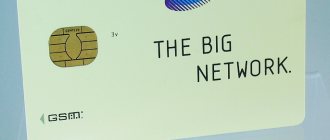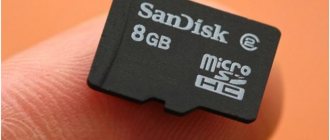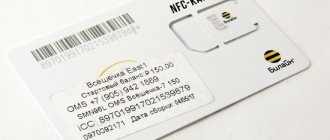Nowadays, technology is developing at a rapid pace, so manufacturers have to keep up with the pace of progress. A good example is the presentation of the iPhone 5 by Apple several years ago.
The device began to use a nano sim to receive a cellular signal. Mobile operators were forced to adapt and make a new version of the SIM card. Let's take a closer look at the difference between nano sim and micro sim.
Let's start with the main thing. What is a SIM card?
A SIM card is a contact smart card with its own processor , capable of registering with a mobile network. "Simka" can find the nearest transmitting station and store information: numbers, SMS and other data.
The SIM card has permanent (non-volatile) and RAM memory. There is also a hardware encryption module and a hardware random number generator.
The SIM card processor operates at up to 10 MHz . The permanent memory is divided into areas: approximately 60% is occupied by operator data, 20% by the operating system, and the rest by user data.
History of the creation of a SIM card
The first mobile phones available to a wide range of users, or as they said then, cell phones, worked according to the 1G standard. When connected, there was no separate SIM card with a number; the phone was a simple device without a connector. The number was assigned according to the factory batch of the model; an operator code and a set of numbers were also programmed into the device’s memory, which were assigned to a specific subscriber. In case of loss or replacement of the device, it was necessary to contact the operator’s office to reprogram the number to a new model.
This is interesting!
The idea of using SIM - Subscriber Identification Module or subscriber identification module was proposed by the Finnish company Radiolinija in 1991; later, with the widespread adoption of the GSM standard, cellular operators around the world began to implement this technology.
But already in the mid-90s, the 2G communication standard became widespread, and it is still in use today. Mobile phones became more accessible and compact, the need for subscriber independence from the device arose, mobile phones became inexpensive and were often replaced by new models.
How are SIM cards made?
It all starts with chip production. Among the most famous manufacturers are Samsung, ST Microelectronics, Infinion.
After this, the modules are removed from the tapes and attached to a plastic base. After that, each module is loaded with an operating system and applications.
The final step is flashing unique data for each card. These are ICCID and PIN codes, keys, identifiers, etc.
SIM card functions
When replacing a phone, just remove your SIM card from one device and insert it into another - the number, balance, as well as the numbers saved on it will become available after turning on the gadget. This is possible thanks to special settings that include three main functions:
- telephone book;
- incoming/outgoing SMS;
- lists of incoming/outgoing calls.
All formats have a chip where data is written. By default, one phone number is connected to one SIM card, but some cellular operators have the ability to assign additional temporary numbers; they can be turned on and off as needed. This is convenient for sales, provision of services, and so on, the main number remains hidden, and the additional number is illuminated for advertising.
Each SIM card has a PIN and PACK code. The first one is used to enter the phone menu, it is standard for all new users, it is better to change it to a complex one, this will help secure data in case of loss of the device or card. The second code is necessary to restore the first, both of them are written on the box from which the SIM card was removed.
Manufacturers of modern smartphones are increasingly using miniature versions of SIM cards to make devices even thinner. Models have already begun to appear where there is no slot, and the number and all other data are recorded in the phone’s memory. Technologies are updated every year, and the abandonment of familiar things is only a matter of time.
How does a SIM card work?
Without a small chip, not a single mobile device will work - it is the small golden square that provides the possibility of cellular communication. Do you understand what we owe communication to? Chips are embedded not only in mobile phones and tablets, but also in ATMs, terminals, and other types of equipment.
Micro-SIM and nano-SIM are different standards that have become firmly established in modern life. Let's talk about what the device consists of! This is not just a piece of trivial plastic, but a complex technology consisting of several layers:
- Plastic base;
- Sealed filling;
- Connecting wires;
- Semiconductor crystal;
- Metal contacts.
Technically, it is a computer made up of eight pins. And here is the first difference between nano and micro SIM cards - modern nano cards have only six contacts!
The structure includes:
- Own processor powered by phone battery;
- RAM needed to perform operations with numbers and support the interface;
- Internal memory used to save contacts, messages and calls;
- Random number generator;
- Encryptor module for generating passwords.
Mini, micro-sim and nano-sim contain certain information that is necessary for full operation:
- Unique serial number (ICCID);
- International Communications Identifier (IMSI);
- Encryption and authentication;
- Information about the local network;
- List of user services;
- PIN or personal identification number to use;
- PUK or Personal PIN Unlock Code.
The subscriber connection algorithm is based on the following principles:
- IMSI allows you to identify the card in the operator’s individual network;
- The first three digits of the identifier are the country code;
- The next 2-3 digits are the mobile network code;
- The last digits are the subscriber’s personal number;
- Each card has a unique authentication key assigned by the operator during personalization;
- The card allows you to receive data from your phone using a key;
- After starting up the mobile equipment, the IMSI is transmitted to the operator, access and identification are requested. Now you can chat!
Types of SIM cards for smartphones and phones
Initially, GSM networks did not use SIM cards. Instead, the mobile operator registered the factory number of the mobile phone to identify the subscriber. This method of identification was inconvenient, since it is hard for the user to connect to the existing phone.
To solve this problem, a SIM card was invented. This small module was installed in the phone and used to identify the subscriber. And in case of replacing a mobile phone, the user could simply move the SIM card into the new device and continue to use mobile communications.
During its existence, the size of the SIM card has constantly decreased. In total, 4 types of SIM cards appeared, each of which is smaller than its predecessors.
- Full-size SIM cards . The first generation of SIM cards appeared in 1991 and were the size of a bank card. Nowadays such SIM cards are called full-size and are no longer used. This format is so outdated that most smartphone users have no idea that it even existed.
- Mini-SIM cards . In 1996, a Mini-SIM card appeared with significantly reduced dimensions. It is this SIM card that we are accustomed to consider as “standard”, although in fact it is a smaller version of a full-size card. It was actively used in phones from the mid-90s to the mid-2000s. Now Mini-SIM is practically not used in new phones, but if you come across an old device, for example, Nokia 3310, then there will be a connector specifically for mini-SIM.
- Micro-SIM cards . The next step in reducing the size of the SIM card was the emergence of Micro-SIM, which was introduced in 2003. In addition to the reduced size, this card has received a number of other improvements, for example, an expanded phone book. Now this SIM card is already 15 years old, but it continues to be actively used in classic mobile phones and budget smartphones.
- Nano-SIM cards . The latest generation of SIM cards is Nano-SIM. This type of SIM card appeared in 2012 and is now the most common. Nano-SIM is used in almost all smartphones in the mid and high price ranges.
Despite the constant miniaturization of size, the location and shape of the contact pads of the SIM card, as well as the operating principle of the processor built into it, have remained virtually unchanged. This allows you to use modern SIM cards in older phone models. But, it should be noted that some older phone models may not work with modern SIM cards. The problem is that old SIM cards operated at 5 Volts, while modern cards only use 3 Volts. Therefore, if the phone supplies a voltage of 5 Volts to the card, it will go into protection and will not be detected by the phone.
Differences from micro-SIM cards
The question “Which type of SIM card is better?” should not be in front of the user. NanoSIM differs from its predecessor only in dimensions. Technical specifications, including communication standard support and number storage capacity, remain unchanged. But it is important to understand that chips change every year. Therefore, timely replacement of the card allows you not only to avoid damage to the device, but also to obtain advanced functions.
For example, many clients of mobile operators complain that their phone does not receive 4G, although this feature is present in the technical specifications. The problem does not arise from the fact that a person uses MicroSIM instead of NanoSIM, but from the date of purchase of the device. Chips released before 2013 cannot, a priori, support fourth generation networks. In this regard, we must once again advise you to replace the card if it was purchased a very long time ago.
Types of SIM cards
There are three main formats: mini, micro and nano. What are they?
Mini-SIM
Mini-SIM is the scientific name for a standard SIM card. Its dimensions are 25x15 millimeters.
If the phone was released before 2011 (inclusive), you can be sure that it is the Mini-SIM . For modern smartphones, such a card is too large, but this does not mean that Mini-SIM is an anachronism. Standard SIM cards are used in simple dialers, in phones with large buttons for the elderly, in secure phones for fishing enthusiasts and factory workers. The listed devices cannot boast of an abundance of functions, so there is plenty of space inside their cases - in some models, manufacturers even allow you to install 3-4 Mini-SIM .
Micro Sim
Micro is a SIM card that first appeared in the iPhone 4 smartphone from Apple. Micro SIM card size – 15 x 12 mm.
At the moment, many manufactured phones have slots for microsim installed.
After Apple, Nokia began using the microsim, and then HTC, Blackberry, and Samsung joined in, as they did not want to differ from the market leaders.
Nano-SIM
Nano-SIM is the newest and smallest phone card. Its dimensions are only 12x5 millimeters. Visually, the card is a chip with a minimum of plastic edging.
Apple is again the innovator. It was the Nano-SIM that users had to insert into the iPhone 5th modification. Later, other well-known manufacturers began to produce devices with Nano-SIM slots - for example, Samsung and Meizu .
The following illustration will help you understand the differences between the three types of SIM cards:
What is eSIM
This is a chip (embedded SIM - built-in SIM) that is installed inside a smartphone or other device. You can record the same information on it as on a regular SIM card.
To connect an eSIM to the operator’s network, you need to receive a set of encrypted data from it and save it.
eSIM saves space inside the smartphone. The chip can be installed anywhere, and since you don’t need to take it out, there won’t be a hole for a “clip” in the case. Protection from dust and moisture is easier to organize.
In addition, to change the operator, you do not need . You can even connect to several operators - save different profiles with your own settings.
People started talking about eSIM when Apple released the iPhone XS/XR/XS Max. Previously, built-in SIM cards were used in the 2016 Samsung Gear S2 3G smartwatch and Apple Watch 3/4. Received eSIM support and Google Pixel 2 smartphone.
The problem is that not all operators support the technology. And in some countries (including the Russian Federation) eSIM is generally illegal .
Firstly, writing data to an eSIM is equivalent to copying a SIM card. This is a fraud.
Secondly, with eSIM you can switch to a new operator without notifying your previous one. This is a violation of the terms of the contract.
In general, for now eSIM can only be used in certain countries. And not all operators.
Total information
Nano sim and Micro sim are designations for the sizes of SIM cards that are used in a particular device.
NanoSIM is much smaller than microSIM and has dimensions of 12.3 mm by 8.8 mm (while microSIM is 15 mm by 12 mm).
It is important to take this point into account when choosing a device, since a microSIM will not be installed in a port intended for a nanoSIM (although the opposite situation is possible and a smaller card may well work in a larger port).
Moreover, we are talking here only about the size of the plastic field on which the chip is glued.
The chip itself has a standard size - the same one that was implemented in standard SIM cards.
<Fig. 1 Appearance>
What is a Nano-SIM card
A Nano-SIM card is a greatly reduced SIM card that is used to identify a cellular subscriber. Therefore, in order to understand Nano-SIM, you need to make a small digression and talk about the origin and purpose of regular SIM cards.
Nano-SIM card and adapters for Mini and MicroSIM.
A SIM card is a special module with a chip that is installed in a mobile phone and is used to identify the subscriber. SIM cards are used exclusively in GSM cellular networks, but similar modules are also used in other types of cellular networks. For example, UMTS networks use USIM, while CDMA networks use R-UIM.
In first-generation GSM networks, the factory mobile phone number was used to identify the subscriber. As a result, the phone was strictly tied to the subscriber and if the phone was changed, the user had to contact the cellular provider to change the recorded factory phone number. This work scheme was inconvenient for both users and mobile operators. Therefore, an alternative subscriber identification scheme was proposed, which uses a SIM card, as well as an IMEI number that is stored in the phone’s memory.
Thus the SIM card appeared. Its main task is to store information necessary to identify the user of mobile services. It allows the user to change the mobile phone as often as necessary. In this case, there is no longer any need to contact your mobile operator.
In addition to identification information, the SIM card allows you to store some additional information, for example: the user’s phone book, a list of incoming and outgoing calls, as well as the text of received and sent SMS messages. This allows you to quickly transfer user data from one mobile phone to another.
Nano-SIM card dimensions
The first generation of SIM cards had a size similar to the size of a bank card. But, with the development of mobile technologies, it became clear that this size is unnecessary and the SIM card needs to be reduced.
Sizes of Mini-SIM, Micro-SIM and Nano-SIM cards.
As a result, its size was reduced several times, each time giving it a new name. This is how Mini-SIM, Micro-SIM and Nano-SIM appeared.
- Full-size SIM cards (1FF) appeared in 1991, measuring 85.6 by 53.98 millimeters and 0.76 millimeters thick. An outdated standard that was used in the first mobile phones, but is no longer used.
- Mini-SIM cards (2FF) appeared in 1996, their size is 25 by 15 millimeters and a thickness of 0.76 millimeters. Cards of this standard were actively used from the early 2000s to the early 2010s. Now, in new phones, Mini-SIM cards are practically not used.
- Micro-SIM cards (3FF) appeared in 2003, their size is 15 by 12 millimeters. Cards of this standard began to be used in the mid-2000s and are still used today. Now Micro-SIM is most often used in push-button phones and budget-level smartphones.
- Nano-SIM cards (4FF) appeared in 2012, their size is 12.3 by 8.8 millimeters. Cards of this format began to be used in the early 2010s and are still used today. The first device with a slot for Nano-SIM cards was the iPhone 5, which was introduced in September 2012. Now Nano-SIM is used mainly in mid-range and flagship smartphones.
Further reduction in the size of the Nano-SIM card is difficult, so the next step is to switch to an e-SIM or built-in SIM card. e-SIM technology assumes that at the production stage a special chip is installed in a mobile phone, and the cellular operator transmits to the subscriber a set of data that must be entered into the device for identification. After entering this data, it is written to the chip, and it acts as a SIM card.
Story
The appearance of microsims occurred about 7 years ago - then this type of card became widespread, mainly among Asian devices, but over time, European brands began to use this innovation.
But it did not have time to become particularly widespread, since just a couple of years later, Apple developed a nano-SIM, which was introduced into the new iPhone and iPad models.
As always, Asian manufacturers were the first to pick up this innovation, followed by European ones.
The nano format has been widely used for many years. At the moment, this is the minimum possible size of the card, since its subsequent reduction requires a reduction in the size of the main working chip, and this will make it impossible to use the new card in all currently existing device models. After all, absolutely all phones and tablets currently have a standard chip size.
What phones is it suitable for?
iPhone models starting with version 5 support the new standard. Modern smartphones released after 2011 may use the new chip.
Features of a nano SIM card
The key feature on which the name depends is the size. A nano-SIM card is half the size of a micro-SIM, this is due to the advent of modern ultra-thin smartphones and new generation tablets. The innovation gained wide popularity among devices from Apple, then it was followed by flagships from Samsung and Nokia.
In the photo you can see what a nano SIM card looks like. Its dimensions are 12x9 mm, and its thickness is 0.68 mm. This format has many advantages:
- thanks to the compact architecture, it has become possible to use batteries with higher capacity, as well as reduce the thickness of the mobile device;
- equipping with reliable multi-level protection against unauthorized access;
- service life increased;
- Internet access speed has been improved;
- the ability to store several thousand contacts in the phone book on a SIM card.
The size of the nano-SIM card is compact and convenient, but at the same time its functionality and reliability are improved. In addition, at any time you can change your standard SIM card to micro or nano using several methods.
A little theory
Sim card is a chip containing data for communication on a mobile network. For example, subscriber identification number. This is the interface between the user and the cellular operator.
Nano-sim and micro-sim - differences
As for the differences between a nano-SIM and the more common micro-SIM, they consist only in the parameters of the plastic base into which the card chip is inserted - the chip itself, in turn, will be the same in all SIM cards without exception.
Map parameters:
- Micro-sim - 15 x 2.5 millimeters (thickness 0.81 millimeters).
- Nano-sim - 12.3 x 8.8 millimeters (thickness 0.67 millimeters).
Thus, a nano-SIM card is not only smaller, but also thinner, which creates additional difficulties for those users who want to make it themselves from larger SIM cards.
Facts about MicroSD
MicroSD memory card format
- historically one of the earliest in the line of SD standards (or Secure Digital - its creation was the result of further development and improvement of the MMC flash memory standard). MicroSD cards have found the widest use among users of PCs, smartphones, tablets, photo and video cameras.
The maximum capacity of MicroSD cards is 2 GB. The standard size of products of this type is 11 by 15 mm with a thickness of 1 mm. The maximum speed for writing and reading data on a card of the appropriate type is 25 MB/s.
How to cut a SIM card for a nano-SIM?
Next, we will talk about what ways there are to acquire a nano-SIM card.
Using a SIM cutter
The best option to perform the operation is to use a special stapler. It's called a SIM cutter. You can buy the device at a communications store or office supply store. But such a device is extremely rare, although it is inexpensive.
In order for your old SIM card to turn into a Nano-SIM, you need to place the card in the special slot of the cutter and press on its upper part. Built-in cutters will cut the card. This will allow you to install it in a new smartphone that supports the NanoSIM standard.
Despite the fact that the SIM cutter is specialized equipment, the operation must be performed as carefully as possible. The SIM card must be clearly installed in the devices, and the chip itself must not fall under the built-in cutters. One wrong move can cause the card to break and become unusable.
Cutting the SIM card manually
If you are convinced of your accuracy, then you can perform the procedure of shortening the SIM yourself using standard scissors, and you only need to select another sample, based on which you should subsequently cut off the excess plastic space. The process is presented in several stages:
- Attach the template to a SIM card with a similar chip location;
- Hold the samples firmly to keep them still while performing;
- Cut off the side areas, being careful not to touch the workspace;
- Eliminate excess plastic along the golden portion;
- Upon completion of the manipulations, separate the small corner and slightly round the edges.
Changing the SIM card format to a more compact one is relatively easy since no special tools or experience are required, and it is most likely that the procedure will be implemented correctly on the first try. However, if you are unsure, it is advisable to contact a professional or change the SIM to a new standard.
It is also extremely important to create a backup copy of your data before starting the procedure, since there is still the possibility of accidental damage, while important phone numbers and other personal information will always remain.
We believe that you now know the basic details about the dimensions and formats of SIM cards, so upon completion, it is recommended that you watch the video tutorial, which demonstrates the procedure in practice.
Contact your telecom operator
The simplest and surest way. You just need to come to the communication store with your phone and passport and order a SIM card replacement service. You will receive a new card of a suitable format, while your phone number, balance and connected services will be saved.
Recently, operators have been offering subscribers multi-format SIM cards that are suitable for all types of phones. The outer shell is a mini-SIM, from which you can squeeze out a micro-SIM or nano-SIM along the indicated dotted line. You risk nothing and use communication services without any problems.
This service is completely free. In some cases, you need to pay a small amount, which will remain in your account. This option is offered by the operator Tele2.
Let's go to the workshop
Purchasing microSIM sizes from another standard is relatively simple, since the physical area of the chip is the same, with only changes in the amount of empty space around it. Today, the vast majority of mobile services have a special tool that makes it easy to separate excess plastic. In practice, the process goes quickly.
Probably, after purchasing and discovering an unsuitable SIM card standard, the consultant may suggest immediately cutting it to the required format, or contacting a service center for the appropriate service. The disadvantages include the fact that any events are paid, so the performer will require about 100 rubles. Additionally, you will need to contact a third-party technician, since careless use of the stapler can damage the chip.
How to insert NanoSim into MicroSim slot
We figured out the differences between nano sim and micro sim. Now let's move on to what to do if you have a nano format card and need to insert it into the micro connector. To ensure backward compatibility of devices, manufacturers produce special adapters.
Adapters for SIM cards
They are made of plastic, and they completely solve the problem with all cards.
The only thing is that you need to insert it carefully so as not to damage the adapter, which is sometimes somewhat thicker than the connector itself.
Why is this necessary?
Why did you need to change the size of the SIM card at all?
The mass introduction of reduced-size SIM cards occurred about seven years ago.
It was due to the fact that the devices were rapidly becoming more complex and receiving more and more voluminous internal “electronic” filling, while manufacturers simply could not increase their size any further.
Thus, a SIM card reduced first to a mini format, and then to a nano format, helps to save quite a lot of space.
Although at first glance, for the user himself, the difference seems insignificant, when it comes to microelectronics, it turns out to be very significant. In addition, this allows you to significantly reduce the size of the card port, which also saves significant time.
<Fig. 4 Adapters>
Conclusion
We looked at what the new format cards are. If the old card is not the right size for use in the new phone, exchange it for a new one or cut it yourself. Reduce size carefully. If the chip is damaged, the card cannot be restored.
Sources
- https://www.iphones.ru/iNotes/sekrety-sim-karty-o-kotoryh-vy-ne-znali-06-16-2019
- https://RuBrowsers.ru/uncategorized/sim-karta
- https://4gltee.ru/mikro-sim-i-nano-sim-raznitca/
- https://SmartPhonus.com/%D0%B2%D0%B8%D0%B4%D1%8B-%D0%B8-%D1%80%D0%B0%D0%B7%D0%BC%D0%B5 %D1%80%D1%8B-sim-%D0%BA%D0%B0%D1%80%D1%82-%D1%81%D0%BC%D0%B0%D1%80%D1%82%D1 %84%D0%BE%D0%BD%D0%BE%D0%B2/
- https://protabletpc.ru/advice/kak-obrezat-sim-kartu.html
- https://SetPhone.ru/stati/vidy-sim-kart-razmery-obrezka/
- https://PoiskTehniki.ru/smartfony/viborsmartphones/nano-sim-i-micro-sim-v-chem-raznica
- https://sravnismart.ru/sim_card_slot/
- https://SmartPhonus.com/nano-sim-%D1%87%D1%82%D0%BE-%D1%8D%D1%82%D0%BE-%D1%82%D0%B0%D0%BA %D0%BE%D0%B5/
- https://geek-nose.com/nano-sim-i-microsim/
- https://public-pc.com/chto-takoe-nano-sim-karta/
- https://besprovodnik.ru/nano-sim/
- https://konekto.ru/nano-sim-karta-chto-jeto-takoe.html
- https://KakOperator.ru/lifehacks/chto-takoe-nano-sim-karta
- https://xiaomium.ru/vidy-razmery-sim-kart-smartfonah











